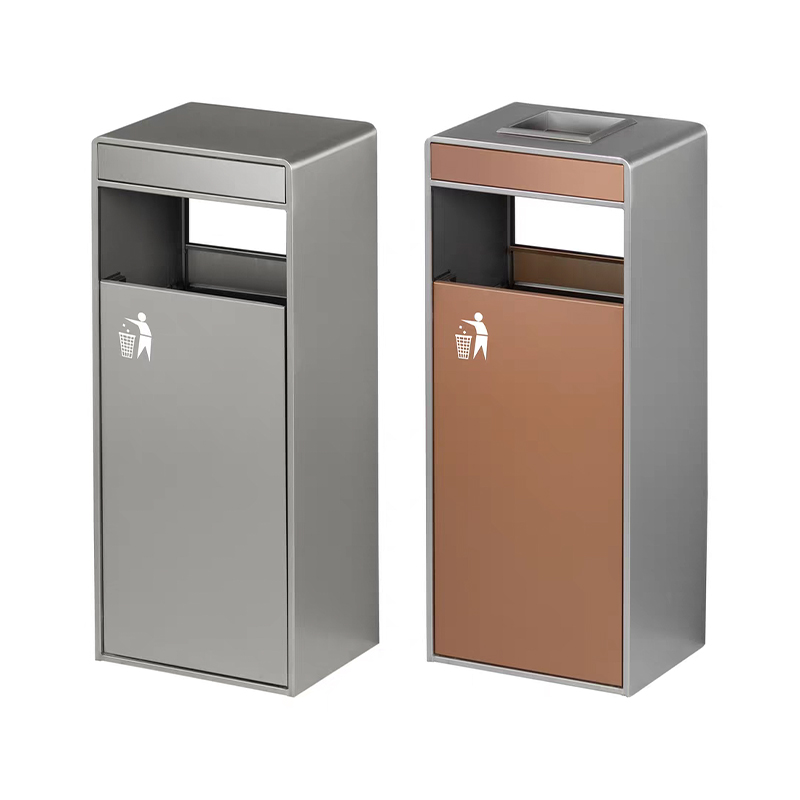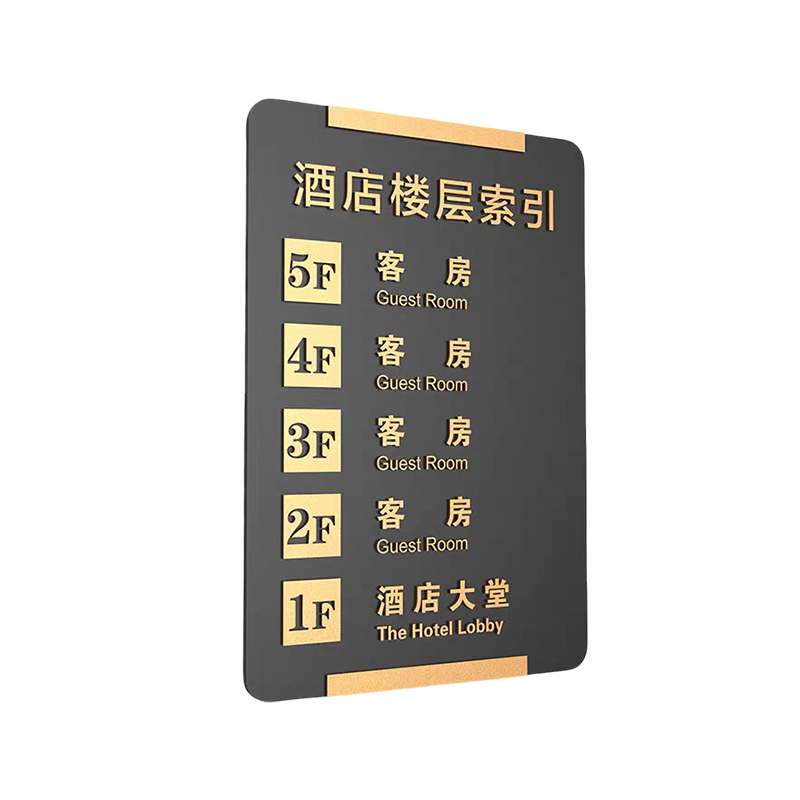How do garbage cans build a solid fortress for waste disposal?
Release Time : 2025-11-06
In urban public spaces and commercial environments, garbage cans may seem ordinary, but they are crucial infrastructure for maintaining environmental hygiene and reflecting urban civilization. Day after day, they endure wind and sun, trampling, frequent opening and closing, and even malicious damage, yet they silently safeguard cleanliness and order. Today, with leaps in materials science and manufacturing processes, high-end garbage cans have transformed from simple containers into urban furniture that combines strength, aesthetics, and functionality. Using SUS304 stainless steel, aluminum plates, and acrylic glass as core materials, combined with fiber laser cutting, laser welding, and precision surface treatment processes, modern garbage cans are building a solid fortress for waste disposal with their robust structure.
1. Core Materials: Constructing a Corrosion-Resistant and Highly Durable Physical Defense
SUS304 stainless steel is the preferred structural material for garbage cans. This food-grade stainless steel, with a high chromium-nickel content, possesses excellent corrosion resistance, oxidation resistance, and mechanical strength. Even in damp hospital corridors, coastal parks, or high-traffic train stations, it can withstand long-term erosion from rainwater, cleaning agents, and even disinfectants, preventing the embarrassment of rust. Lightweight, high-strength aluminum alloy sheets are used for the frame or decorative components, reducing overall weight while maintaining structural rigidity. Transparent or colored acrylic glass panels are cleverly embedded in the bin body, enhancing visual transparency and modern aesthetics, and making it easier for the public to identify classification labels or internal waste capacity, achieving a unity of functionality and design.
2. Precision Machining: Laser Technology Brings a Seamless Industrial Aesthetic
Traditional welding easily leaves weld scars, deformation, or burrs, affecting aesthetics and trapping dirt. Modern high-end garbage cans utilize fiber laser cutting for precise panel cutting, with an error controlled within ±0.1mm, ensuring a seamless fit for every component. Laser welding edge forming technology then achieves a near-invisible weld effect—smooth, mirror-like welds without protrusions or pores, significantly improving overall sealing and ease of cleaning. This "one-piece molding" process not only enhances structural stability but also endows the garbage can with a simple and streamlined industrial aesthetic, allowing it to blend harmoniously with its surroundings, even when placed in high-end shopping malls or international airport lobbies.
3. Surface Finishing: Meticulous Details Balancing Aesthetics and Practicality
To meet the aesthetic needs of different scenarios, garbage can surfaces can be electroplated or treated with environmentally friendly powder coating. Electroplating offers a dense, wear-resistant, and long-lasting shine, suitable for luxurious hotel lobbies or boutiques; while matte paint provides a subtle and understated look, resisting fingerprints and easy to wipe clean, making it more suitable for high-frequency use locations such as schools and hospitals. Regardless of the manufacturing process, all garbage cans undergo rigorous salt spray testing and abrasion resistance certification to ensure they do not fade or peel during long-term use, consistently maintaining a professional image.
4. Flexible Customization: Intelligent Space Adaptation to Diverse Scenarios
From narrow subway passages to open city squares, from densely populated school campuses to bustling airport terminals, different scenarios present varying requirements for the size, capacity, and opening method of garbage cans. High-end products support full-size customization—height adjustable from 60cm to 120cm, capacity ranging from 20L to 240L, and can be configured with features such as foot-operated opening, sensor opening, dual-compartment sorting, and ash separation. This "on-demand customization" capability transforms garbage cans from generic municipal standard equipment into truly integrated intelligent terminals that seamlessly integrate into spatial flow and user behavior.
5. Widespread Deployment: Safeguarding the Cleanliness of Public Spaces
Leveraging the above advantages, these high-end garbage cans have been widely used in supermarkets, shops, airports, train stations, hospitals, schools, parks, and other places with extremely high requirements for hygiene, safety, and image. In hospitals, its resistance to disinfection and ease of cleaning aids in infection control; in airports, its impact resistance and aesthetic appeal reflect the quality of an international hub; in schools, its rounded corners and lack of sharp edges ensure children's safety. Every detail is a silent embodiment of "public responsibility."
Though small, garbage cans are a microcosm of urban civilization. When made with SUS304 stainless steel, laser-cut forging, and customized design, they transcend mere containers for waste, becoming miniature "clean fortresses"—resisting the erosion of time with their robust structure; illuminating public spaces with their exquisite craftsmanship; and silently safeguarding our shared living environment. In today's pursuit of a high-quality urban life, a good garbage can deserves to be taken seriously.
1. Core Materials: Constructing a Corrosion-Resistant and Highly Durable Physical Defense
SUS304 stainless steel is the preferred structural material for garbage cans. This food-grade stainless steel, with a high chromium-nickel content, possesses excellent corrosion resistance, oxidation resistance, and mechanical strength. Even in damp hospital corridors, coastal parks, or high-traffic train stations, it can withstand long-term erosion from rainwater, cleaning agents, and even disinfectants, preventing the embarrassment of rust. Lightweight, high-strength aluminum alloy sheets are used for the frame or decorative components, reducing overall weight while maintaining structural rigidity. Transparent or colored acrylic glass panels are cleverly embedded in the bin body, enhancing visual transparency and modern aesthetics, and making it easier for the public to identify classification labels or internal waste capacity, achieving a unity of functionality and design.
2. Precision Machining: Laser Technology Brings a Seamless Industrial Aesthetic
Traditional welding easily leaves weld scars, deformation, or burrs, affecting aesthetics and trapping dirt. Modern high-end garbage cans utilize fiber laser cutting for precise panel cutting, with an error controlled within ±0.1mm, ensuring a seamless fit for every component. Laser welding edge forming technology then achieves a near-invisible weld effect—smooth, mirror-like welds without protrusions or pores, significantly improving overall sealing and ease of cleaning. This "one-piece molding" process not only enhances structural stability but also endows the garbage can with a simple and streamlined industrial aesthetic, allowing it to blend harmoniously with its surroundings, even when placed in high-end shopping malls or international airport lobbies.
3. Surface Finishing: Meticulous Details Balancing Aesthetics and Practicality
To meet the aesthetic needs of different scenarios, garbage can surfaces can be electroplated or treated with environmentally friendly powder coating. Electroplating offers a dense, wear-resistant, and long-lasting shine, suitable for luxurious hotel lobbies or boutiques; while matte paint provides a subtle and understated look, resisting fingerprints and easy to wipe clean, making it more suitable for high-frequency use locations such as schools and hospitals. Regardless of the manufacturing process, all garbage cans undergo rigorous salt spray testing and abrasion resistance certification to ensure they do not fade or peel during long-term use, consistently maintaining a professional image.
4. Flexible Customization: Intelligent Space Adaptation to Diverse Scenarios
From narrow subway passages to open city squares, from densely populated school campuses to bustling airport terminals, different scenarios present varying requirements for the size, capacity, and opening method of garbage cans. High-end products support full-size customization—height adjustable from 60cm to 120cm, capacity ranging from 20L to 240L, and can be configured with features such as foot-operated opening, sensor opening, dual-compartment sorting, and ash separation. This "on-demand customization" capability transforms garbage cans from generic municipal standard equipment into truly integrated intelligent terminals that seamlessly integrate into spatial flow and user behavior.
5. Widespread Deployment: Safeguarding the Cleanliness of Public Spaces
Leveraging the above advantages, these high-end garbage cans have been widely used in supermarkets, shops, airports, train stations, hospitals, schools, parks, and other places with extremely high requirements for hygiene, safety, and image. In hospitals, its resistance to disinfection and ease of cleaning aids in infection control; in airports, its impact resistance and aesthetic appeal reflect the quality of an international hub; in schools, its rounded corners and lack of sharp edges ensure children's safety. Every detail is a silent embodiment of "public responsibility."
Though small, garbage cans are a microcosm of urban civilization. When made with SUS304 stainless steel, laser-cut forging, and customized design, they transcend mere containers for waste, becoming miniature "clean fortresses"—resisting the erosion of time with their robust structure; illuminating public spaces with their exquisite craftsmanship; and silently safeguarding our shared living environment. In today's pursuit of a high-quality urban life, a good garbage can deserves to be taken seriously.







